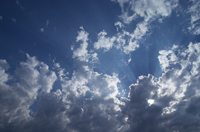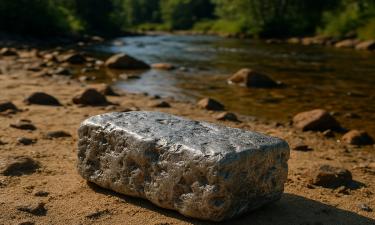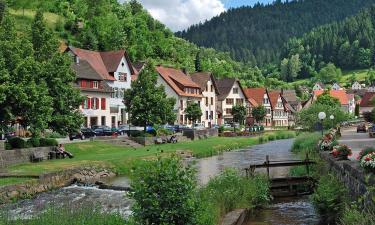Arctic scientists look to the clouds for clues to climate change
Scientists are peering into the clouds near the top of the world, trying to solve a mystery and learn something new about global warming.

The mystery is the droplets of water in the clouds. With the North Pole just 685 miles (1,100 kilometers) away, they should be frozen, yet more of them are liquid than anyone expected.
So the scientists working out of a converted blue cargo container are trying to determine whether the clouds are one of the causes or effects of Earth's warming atmosphere.
"Much to our surprise, we found that Arctic clouds have got lots of super-cooled liquid water in them. Liquid water has even been detected in clouds at temperatures as low as minus 30 degrees Celsius (minus 22 F)," said Taneil Uttal, chief of the Clouds and Arctic Research Group at the Earth Systems Research Laboratory of the U.S. National Oceanic and Atmospheric Administration (NOAA).
"If a cloud is composed of liquid water droplets in the Arctic, instead of ice crystals, then that changes how they will interact with the earth's surface and the atmosphere to reflect, absorb and transmit radiation," said Uttal.
"It's a new science, driven by the fact that everybody doing climate predictions says that clouds are perhaps the single greatest unknown factor in understanding global warming."
With NASA reporting that 2005 was the warmest year on record worldwide, the debate over global warming marches on, but not here. The American and Canadian scientists at the Eureka Weather Station in the northern Canadian territory of Nunavut, like the Inuit who are seeing their native habitat thaw, are beyond questioning the existence of climate change.
"If we compare the debate over the theory of evolution with the debate over the theory of global warming _ global warming's a whole lot more certain at the moment," said Jim Drummond, a University of Toronto physics professor and chief investigator for the Canadian Network for the Detection of Atmospheric Change.
"By and large," he said, "we are not now arguing about whether global warming is going to happen; the argument has turned to: How big is it going to be?"
Uttal, Drummond and other American and Canadian scientists recently visited Eureka, an outpost established jointly by Canada and the United States in 1947 and now equipped with instruments that sound like sci-fi inventions _ the ozone spectrophotometer, for instance, or the tropospheric lidar. (A lidar, an amalgamation of "light" and "radar," uses laser light to detect atmospheric particles.)
The new technology helps to better understand the impact of clouds on Earth's surface temperature. The clouds being studied here range from six miles (10 kilometers)high to almost touching the ground.
"For a couple of decades we have known that super-cooled liquid water droplets could exist in clouds," Uttal said. "But the prevalence of it in Arctic clouds was not really known until these specialized sensors starting operating in the Arctic about eight years ago."
"The really exciting thing," she said, will be the ability to track an aerosol layer or an Asian dust cloud from their source and measure their effect on a cloud.
Uttal noted that water clouds are more likely to warm the Arctic atmosphere than ice clouds, since the liquid clouds retain more heat radiated by the Earth's surface. "This means that the ice-to-water ratios in clouds may be very important in controlling the Arctic surface temperatures and how it melts," she said.
In Nunavut, the melting is keenly felt. "In the old days, we used to have 10 months of winter; now it's six," said Simon Awa, an Inuit leader and deputy minister for the environment of Nunavut who was on the trip to Eureka. "Every year we're getting winter later and later."
For these 155,000 people of Canada, Greenland, Russia and the United States, it means less time to hunt caribou, walrus and polar bear. Studies show that average winter temperatures have increased as much as 7 degrees F (3.9 degrees C) in the Arctic over the last 50 years. The permafrost ground that is continually frozen for at least two years is thawing, imperiling polar bears and forcing other animals to migrate farther north.
The walrus have moved farther away, said Awa. "So you're taking more time out, away on the land hunting." Meanwhile, families back home are forced to eat store-bought food that is costlier and less healthy.
"The majority of the world's population hasn't really felt the global warming," said Awa. "But right now in the Arctic and in Nunavut, we're really worried because it's already affecting us. We are a thermometer of the world for what could happen."
Russ Schnell, director of Observatory and Global Network Operations for NOAA, notes that climate change is cyclical that the planet's vegetation, over millions of years, sucks in and spits out carbon dioxide, reports AP.
"All the carbon dioxide in the coal and oil was once in the air. The plants took it and it went into the oceans or into the ground and now we're taking it back out," says Schnell.
"The cycle is the same today, only you're taking something that took 100,000 years and doing it in one hundred years," he said. "There's a point where animals can't change fast enough, there's a point where plants can't change fast enough, so they'll either compete it out or go extinct."
Subscribe to Pravda.Ru Telegram channel, Facebook, RSS!





